

© Shipping Wonders of the World 2012-

The Adventures of Captain Voss
A search for the Cocos Island treasure, a journey across three oceans in a dug-
Captain Voss experienced on his remarkable voyages
GREAT VOYAGES IN LITTLE SHIPS -
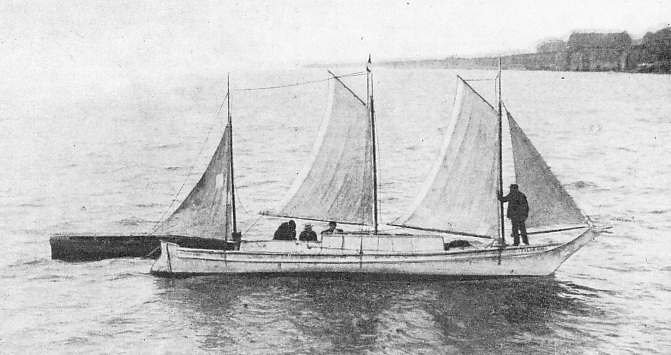
ORIGINALLY A RED INDIAN DUG-
CAPTAIN JOHN C. VOSS, a short, active, quick-
He bought a former dug-
Voss was always studying the sea. He regarded every storm as an experience from which he could learn something. He had had more than twenty years’ experience in sailing vessels of various rigs before he took to tiny craft, and he found that the little vessels taught him much about seamanship. He was an ardent advocate of the sea-
Most men regard gales as terrible ordeals when they go to sea in small craft, but Voss regarded a gale in the same way that a research scientist considers a new specimen under his microscope. He came to decided conclusions upon the correct handling of vessels in storms. His book, The Venturesome Voyages of Captain Voss, contains an appendix in which he summarizes the whole of his experience. The volume is an important contribution to man’s knowledge of the sea.
Voss, in a long career at sea, brought vessels of many types undamaged through storms that wrecked other ships. He had a proper pride in his seamanship. There was no hesitation or doubt in the mind of Voss when he was at sea in any craft; he was a real master mariner. He mastered his ship and he mastered the sea.
There was a strong streak of romance in Voss’s character, as well as a rich vein of humour. The streak of romance accounts for the otherwise strange fact that Voss bought a 10-
Voss had more grounds for optimism than most Cocos treasure-
Nearly all these treasure-
Haffner handed Voss a letter written by a dying man, Jim Dempster, addressed to Voss. Dempster and other men had chartered a schooner and sailed to Cocos, where they had searched in vain. They had found Haffner on the island and had given him a passage back to Victoria. Haffner had told Dempster he knew where the treasure was. When Dempster had become ill Haffner had nursed him, and the dying man had told him to seek out Voss. Haffner told Voss he had not taken the other men of the schooner into his confidence because he did not trust them.
Voss found a 100-
Treasure Hunt on Cocos
It is surprising that some months later, when a letter from Haffner reopened the scheme, Voss immediately jumped at it. Haffner’s new yarn was that an officer had told him that a British admiral visiting Cocos intended to hand the treasure to the British Government for restoration to Peru. On this Haffner had directed the sailors to dig at a wrong spot and then had said he had forgotten where the treasure was; the British had then left Cocos and had landed him at Acapulco, Mexico. All Voss had to do was to get to Acapulco with any kind of vessel and pick Haffner up. They would sail to Cocos and get as much treasure as the vessel would hold, and come back for the rest later.
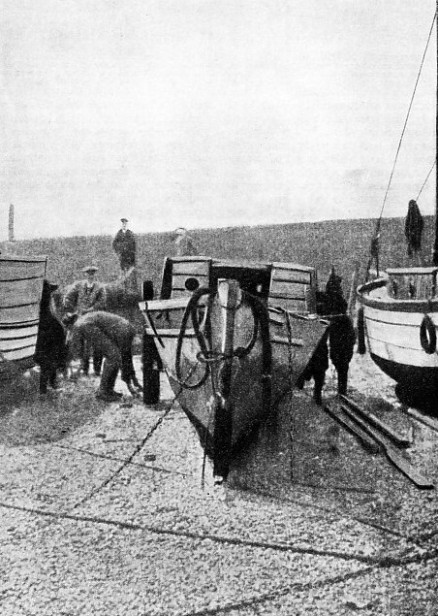 Voss bought a 10-
Voss bought a 10-
FROM VICTORIA, B.C., TO ENGLAND Captain Voss sailed in the Tilikum, the 30-
He had never used a sea-
The Xora put in at San Blas, Mexico, where Voss received news that Haffner had died of fever in Acapulco. The three men talked the matter over and decided, now that they had come so far, to continue to Cocos Island, especially as Voss remembered the chart that Haffner had shown him. On this chart were marked the clues leading to the place where the treasure was said to be buried.
At the island they met a German and his wife. The German, who was the guardian and governor of the place, showed Voss a better anchorage for the yacht. While they were following his directions the vessel ran on a rock and was holed. They managed to repair her and then searched in vain for the treasure. When they had tired of this they sailed to Callao, Peru. Voss had to return to Victoria in a hurry. He therefore put a man on board the Xora and she sailed back while he hastened north.
This trip was made in 1898. A few years later, in 1901, Voss was approached in Victoria by a Canadian journalist named Luxton, who said that £1,000 could be made if Voss sailed a vessel smaller than Captain Slocum’s Spray across the Pacific, the Indian Ocean and the Atlantic. He proposed to go with Voss and they would share the money. Voss agreed and said that he would make the voyage in an Indian canoe to render the feat the more remarkable.

TWO TYPES OF SEA ANCHOR were used by Captain Voss. The Tilikum’s sea anchor consisted of a conical canvas-
He bought the fifty-
Voss made a number of alterations to fit her for going to sea. Her length overall, including the figurehead, was 38 feet, her length on the keel was 30 feet and her greatest beam was 5 ft. 6 in. Voss built up the sides 7 in. and built a cabin 8 feet long and a cockpit; he put lead on the keel and rigged her with three masts. The total sail area was 230 square feet. He had inside ballast as
well as the lead on the keel, and carried about 100 gallons of water in two tanks, three months’ provisions, two rifles, a shot-
Everybody said that she and her crew would come to grief when she sailed from Victoria in May 1901. Luxton had never made a voyage before, but soon proved a good shipmate. The two adventurers spent some weeks with Indians on the coast of Vancouver Island, fishing and hunting. Then they began the long sail to the South Sea Islands. The wind and sea got up, and Voss prepared to ride the storm out to a sea anchor.
When the Tilikum was head to the storm Luxton saw a huge sea towering above the boat and he climbed up the foremast, thinking that the sea would break on board. His weight on the mast nearly capsized the boat, and Voss tugged at Luxton’s life-
After the gale they sighted a sailing ship, went alongside and were given some fresh bread. Then they went on their lonely way. The first landfall was Penrhyn Island. The Tilikum visited Manahiki, Danger Island, Samoa and Fiji. There Luxton decided to go to Sydney by steamer and wait for the Tilikum. He engaged a Tasmanian, Louis Begent, to act as mate to Voss.
Then came tragedy. The young man neglected to fasten his life-
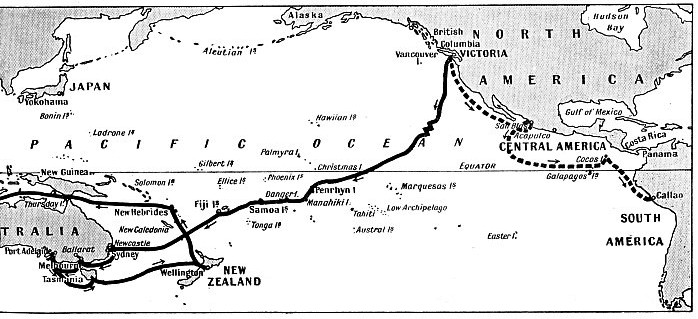
THE VOYAGES OF CAPTAIN VOSS in the Xora and the Tilikum are shown on these maps. With two companions Voss sailed from Victoria, B.C., in 1898, to pick up Haffner, who had the clues for the £7,000,000 Cocos Island treasure. At San Blas, Mexico, Voss learnt that Haffner had died. The Xora then sailed to Cocos and returned to the mainland at Callao, Peru, where Voss left her. Three years later he sailed from Victoria in the Tilikum to emulate Slocum’s voyage in the Spray (described in the chapter “Captain Slocum the Pioneer”) by sailing across three oceans in a smaller craft. Voss’s voyage was not single-
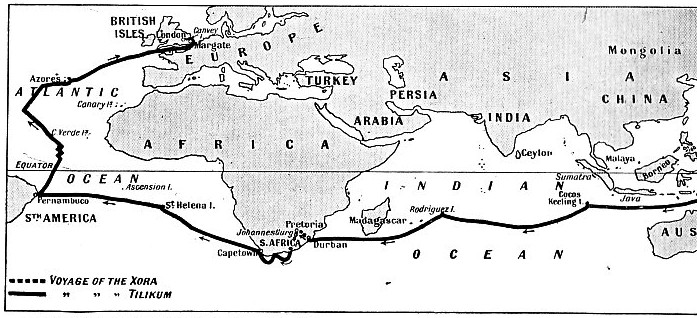
Nearing Sydney she was nearly run down by a steamer; Voss pulled off a sock, soaked it in paraffin and set it alight. The improvised flare was seen and the steamer altered course. Then the canoe was menaced by waterspouts. By the time she reached Sydney she had been given up for lost.
Luxton was so upset by the news of the death of the young man that he decided to end the project. Voss, however, wanted to continue, and became the owner of the Tilikum. He had not the means to buy provisions or hire a mate, and his first consideration was to get money. This he did by turning showman and exhibiting the Tilikum. The harbour authorities charged him pilotage dues for entering the harbour, although he did not engage a pilot. He did not have enough cash to spare to pay the dues for going out, so he took a railway ticket to Newcastle, New South Wales, taking the Tilikum on the train as luggage. When he reached Newcastle to show the boat some people said no doubt he had done a large part of his voyage with the Tilikum as luggage, and he realized that it would be wiser to sail her to any place he could reach by water in the future.
When the Tilikum sailed from Newcastle for Melbourne with a new mate she encountered heavy weather and had to shelter in a bay before she reached Melbourne. There she was put on shore.
While she was being hoisted on to a dray the hook of the tackle snapped and caused the Tilikum to fall to the ground with a crash. Voss went to law and won his case against the firm who had contracted to move her. Then he repaired the canoe and took her by train to Ballarat, Victoria, where he exhibited her. On his return to sea, he sailed to Port Adelaide, South Australia. He and various mates sailed her to Tasmania and then to New Zealand.
With a new mate Voss sailed from New Zealand to the New Hebrides, and on to Thursday Island and north of Australia. He had intended to land in the Cocos-
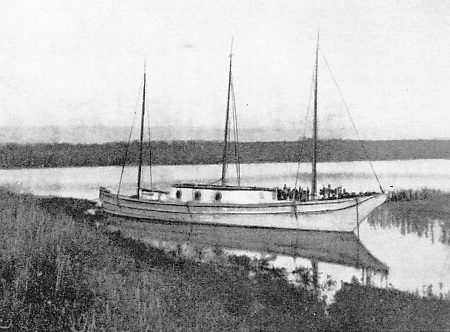
IN A CREEK, at Canvey Island, Essex, the Tilikum lay for some years after her remarkable voyage of over three years from Victoria, British Columbia. For a time she was exhibited at Earl’s Court, London, and eventually was shipped to British Columbia, where she was preserved.
On the passage to South Africa Voss had a set-
On the last long voyage of the Tilikum from Pernambuco to Europe the mate was still sick until the Equator was crossed; then he began to recover. When his sea-
Voss stepped ashore at Margate Jetty after a voyage of three years, three months and twelve days from Victoria, British Columbia. The Tilikum was afterwards exhibited at Earl’s Court, London. Then for some years she lay in a creek at Canvey Island, Essex, and was afterwards shipped to the Pacific coast of North America, renovated and preserved in British Columbia.
Voss became the captain of sealing vessels in the north Pacific until sealing was prohibited for a period of years. He was in Yokohama in 1912, when he was approached by two yachtsmen, F. Stone and S. A. Vincent. Stone was building a small yawl, the Sea Queen, and invited Voss to join him and his friend on a voyage round the world. The yacht had a length of 25 ft. 8 in. overall, and 19 feet on the water-
An Enterprising Shark
She sailed from Yokohama in July 1912, and some days later was hove-
A second start was made. When the yawl had been at sea for about a week she was struck by a typhoon while she was hove-
The temporary sea-
It took Voss several hours to get the water out of the cabin, and during this time Stone was twice washed overboard, but managed to get back each time. The three men took refuge in the cabin. Then the yawl got into the centre of the typhoon, where there was dead calm, and they looked out and saw that both masts had been blown out of her.
When the second stage of the typhoon began there was no gear to catch the wind, and the yawl weathered the seas. At last the typhoon passed. The three men fished (repaired) the broken mainmast, and eventually sailed back to Yokohama. The voyage was abandoned after this ordeal.
Voss was then aged fifty-
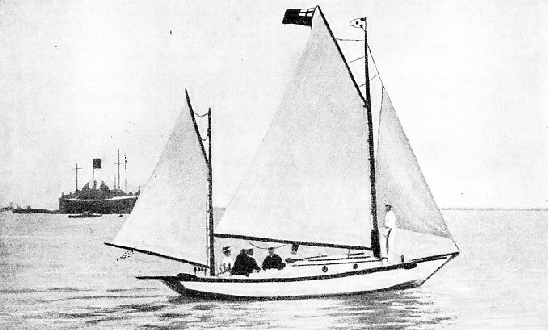
THE SEA QUEEN was struck by a typhoon and capsized after having sailed from Japan, in July 1912. Voss and his two companions were still with the yawl when she righted. With an overall length of 25 ft. 8 in., a beam of 8 ft. 3 in. and a draught of 3 ft. 6 in., the Sea Queen had a sail area of 400 square feet.
You can read more on “Captain Slocum the Pioneer”, “Great Voyages in Little Ships” and “Supreme Feats of Navigation” on this website.